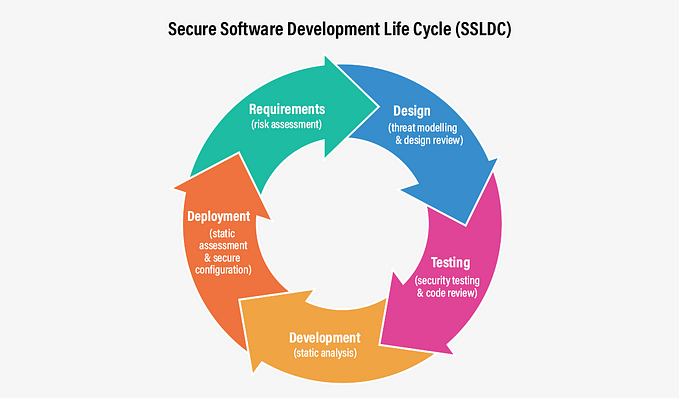Single Sign-On (SSO): Potential flaws or vulnerabilities in the implementation
As an application security engineer, your responsibility is to identify and address potential flaws or vulnerabilities in the Single Sign-On (SSO) implementation.
Here’s a flaw diagram from an application security engineer’s perspective, highlighting some potential security weaknesses in the SSO process:

Potential Flaws and Vulnerabilities:
- Improper Redirects (Open Redirect Vulnerability):
- If the application allows un-sanitised input in the redirect URL, an attacker can craft malicious URLs leading users to phishing or other malicious sites.
Examples of improper redirects issues:
- Redirecting users to a phishing site that looks like a legitimate site in order to steal their login credentials or personal information
- Redirecting users to a site that downloads malware onto their device without their knowledge or consent
- Redirecting users to a site that tricks them into making a payment or giving away sensitive information
- Redirecting users to a site that displays fake error messages or warnings in order to scare them into taking action that is harmful to their device or data
- Redirecting users to a site that is designed to look like a government or financial institution site in order to deceive them into giving away sensitive information
- Redirecting users to a site that injects malicious code into their browser, allowing the attacker to take control of their device or steal their data
2. Weak Authentication Mechanisms:
- If the IDP uses weak authentication methods, such as plain passwords without multi-factor authentication (MFA), it increases the risk of unauthorised access
Examples of weak authentication mechanisms:
- Passwords that are easy to guess or that have been reused across multiple accounts
- Security questions that can be easily answered by an attacker with public information
- Single-factor authentication methods, such as only requiring a password and not a second form of identification
- SMS-based authentication, which can be vulnerable to SIM-swapping attacks
- Weak or common PINs (such as “1234” or “0000”) for mobile devices or other devices with PIN-based authentication
- Biometric authentication that can be easily fooled with fake fingerprints or facial images
- Two-factor authentication methods that rely on SMS messages, which can be intercepted by attackers
- Authentication systems that do not enforce strong password policies (such as requiring a minimum length or a mix of characters)
- Authentication systems that do not lock out users after too many failed login attempts and more.
3. Insecure Communication (Man-in-the-Middle Attack):
- Inadequate transport layer security (e.g., using HTTP instead of HTTPS) could expose the authentication process to interception by attackers.
- To ensure the security of the connection, it is recommended to use secure cipher suites such as TLS_AES_256_GCM_SHA384 or TLS_CHACHA20_POLY1305_SHA256. These cipher suites use strong encryption algorithms and key lengths to protect the data being transmitted and are recommended by security experts.
4. Insufficient Token Validation:
- Lack of proper validation of the security token may allow an attacker to forge or tamper with tokens, leading to unauthorised access.
- When generating tokens, use a cryptographically secure random number generator and ensure that the tokens are sufficiently long and complex.
Examples of insufficient token validation issues:
- Accepting a token without checking its expiration date
- Accepting a token without verifying its signature
- Accepting a token without checking whether it was issued by a trusted authority
- Accepting a token without checking the token’s intended audience
- Accepting a token without verifying that the token was issued for a specific purpose
5. Token Lifetime Issues (Session Hijacking):
- If the token’s expiration time is too long, attackers can potentially steal and reuse the token for an extended period, increasing the risk of session hijacking.
- Revoking long-lived tokens can be difficult, especially if many systems have been authorised to use them.
Examples of token lifetime issues:
- Token expiration: If a token has a short lifespan and expires too quickly, it can cause issues for users who need to use the token for an extended period of time
- Token leakage: If a token is transmitted insecurely or stored in an insecure location, it can be compromised and used by an attacker
- Token revocation: If a user’s access to a resource is terminated, but their token is not revoked, they may still be able to access the resource using the token
- Token replay: If a token is intercepted and replayed by an attacker, they can use the token to access resources even if they have not been authorised to do so
- Token theft: If an attacker gains access to a user’s token, they can use it to impersonate the user and access resources they should not have access to
6. Inadequate Session Management:
- Poor session management practices may lead to session fixation attacks or session hijacking.
Examples of inadequate session management issues:
- Lack of session timeouts: Sessions should expire after a certain period of inactivity, otherwise it leaves the user vulnerable to session hijacking attacks
- Session fixation: In this attack, an attacker sets the session ID value for the user’s session and then tricks the user into using the session ID. The attacker can then hijack the session
- Session hijacking: This occurs when a malicious user gains access to a legitimate user’s session ID and takes control of the session. This can be done through various means such as packet sniffing or cross-site scripting (XSS) attacks
- Session prediction: This occurs when an attacker can guess a valid session ID and use it to access the user’s session
- Session revocation: This occurs when a legitimate user logs out of their session, but the session ID remains active and can be used by an attacker to gain access to the user’s account
7. User Enumeration:
- If the IDP responds differently for existing and non-existing users during authentication, it can enable user enumeration attacks.
8. Missing Single Logout (SLO):
- The lack of SLO support might leave users vulnerable to unauthorised access if they don’t explicitly log out from all applications.
Examples of missing single logout issues:
- When a user logs out from one service provider but remains logged in to another service provider
- When a user logs out from a service provider, but the session is not terminated on the identity provider side
- When a user’s session is terminated on the identity provider side, but the service provider session remains active
- When a user closes their browser without logging out, leaving their session active on both the service provider and identity provider side
- When a user’s session times out on the identity provider side, but the service provider session remains active
- When a user logs out from a service provider, but the identity provider session is not terminated
9. Cross-Site Scripting (XSS):
- If the application fails to sanitise user input or outputs token data without proper escaping, it could lead to XSS attacks.
Examples of Cross-site scripting issues:
- Malicious actors injecting scripts into the SSO login page to steal login credentials
- Redirecting users to a fake login page to steal login credentials
- Injecting scripts into the SSO session cookie to hijack user sessions
- Using XSS to bypass security controls in the SSO implementation and gain access to sensitive data
- Reflected XSS attacks, where an attacker tricks a user into clicking a malicious link that executes a script on the SSO login page and steals login credentials
- Stored XSS attacks, where an attacker injects a script into data stored within the SSO system, such as user profiles or messages, that is then executed when viewed by another user
- DOM-based XSS attacks, where an attacker exploits a flaw in the SSO implementation’s client-side code to execute a script that steals login credentials or other sensitive data
10. Token Leakage:
- If the application inadvertently exposes the token in logs, URLs, or referer headers, it can lead to token leakage.
Examples of token leakage issues:
- When a user copies a session ID or token from a URL and sends it to another user who then uses it to access the original user’s account
- When a website includes a user’s session ID or token in a URL that is then shared or bookmarked, allowing someone else to access the user’s account
- When a website includes a user’s session ID or token in a cookie that is then stolen or intercepted by a third party
- When a user accesses a website over an unsecured connection, allowing an attacker to intercept the user’s session ID or token
- When a user’s session ID or token is stored in plaintext in a database and the database is compromised
- When a website’s server logs are not properly secured and a hacker gains access to them, obtaining user session IDs or tokens
Conclusion
In this post, I aim to emphasise the importance of addressing potential flaws by following security best practices:
- Conducting security assessments
- Implementing secure coding practices
- Using strong authentication mechanisms (such as MFA)
- Configuring secure communication (HTTPS)
- Implementing proper token validation and management
- Ensuring secure session handling throughout the SSO process
Regular security testing and audits are essential to identify and remediate any flaws in the SSO implementation.









